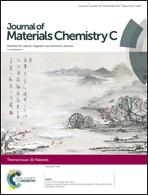Combining 2D inorganic semiconductors and organic polymers at the frontier of the hard–soft materials interface
Abstract
Two-dimensional semiconductor materials, such as transition-metal dichalcogenides (TMDCs) and black phosphorus (BP), have emerged as materials of great promise for the future of electronic materials. However, a significant challenge in the application of 2D materials in optoelectronic devices is the lack of precise control over charge carrier doping and in some cases an inherent chemical instability. This Highlight discusses recent advances in combining polymers with 2D TMDCs and BP in studies aiming to improve device performance, photostability, and/or chemical stability. We emphasize non-covalent polymer functionalization approaches which do not rely on the presence of lattice defects in the 2D materials or on surface functional groups that hinder charge transport. We also describe challenges associated with the design of these hard–soft material interfaces and directions for progress.

- This article is part of the themed collections: Recent Review Articles and 2D Materials


 Please wait while we load your content...
Please wait while we load your content...